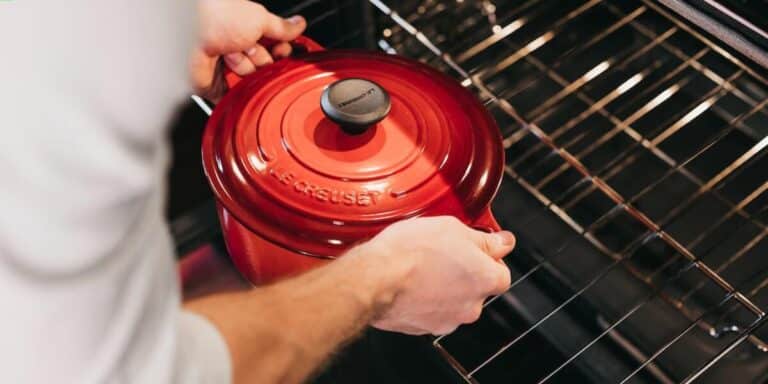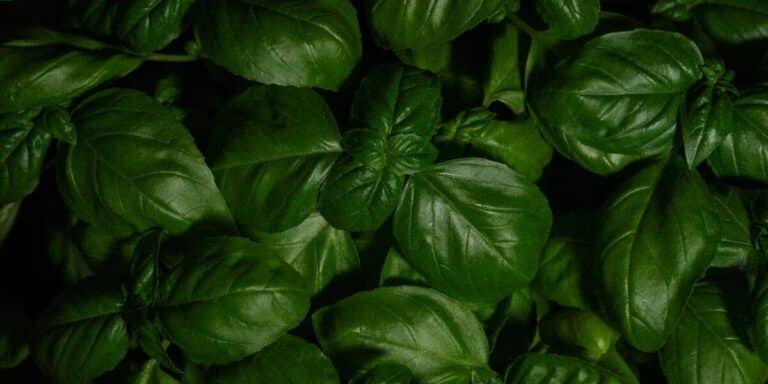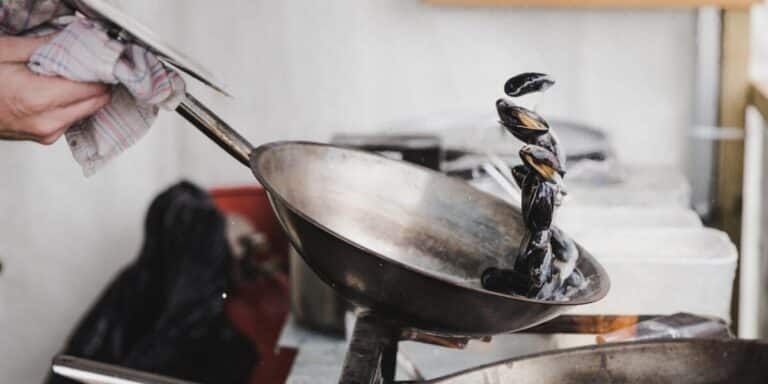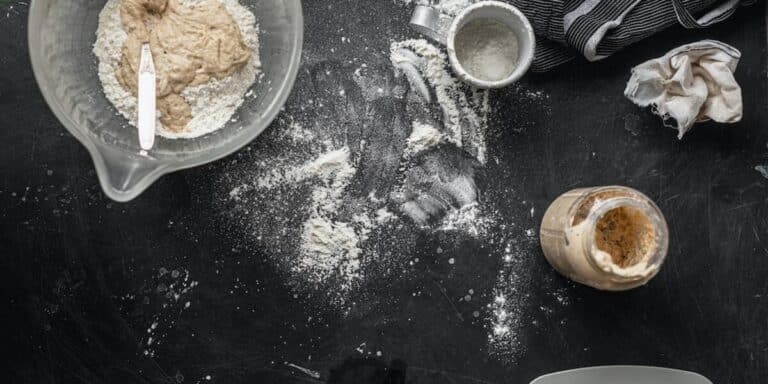What Ratio of Garlic Powder Equals Fresh Garlic?
You may think that substituting garlic powder for fresh garlic is a straightforward process, but don’t be surprised if the flavor doesn’t quite match up. The concentrated nature of garlic powder means that a little goes a long way, and using the wrong ratio can leave your dish tasting bitter or overpowering. As a general guideline, 1/4 teaspoon of garlic powder is often used to replace one clove of fresh garlic, but this can vary depending on the specific type of garlic powder and the recipe you’re using. So, how can you guarantee the perfect balance of flavor?
Key Takeaways
• 1 clove of fresh garlic is equivalent to approximately 1/4 teaspoon of garlic powder, serving as a standard conversion ratio.
• A general guideline is 1/4 to 1/2 teaspoon of garlic powder equals one clove of fresh garlic, allowing for flexibility in recipes.
• The ideal ratio of garlic powder to fresh garlic may vary depending on personal taste preferences and desired flavor intensity.
• When substituting garlic powder for fresh garlic, start with a smaller amount (about 1/4 teaspoon) and adjust to taste to avoid overpowering the dish.
• The conversion ratio can be adjusted based on the type of garlic, cooking method, and other ingredients used in the recipe.
Understanding Garlic Powder Substitution
When substituting garlic powder for fresh garlic, you’ll need to ponder the differences in flavor and potency to achieve the desired taste. You’ll notice that garlic powder is more concentrated than fresh garlic, so a little goes a long way. One clove of fresh garlic is equivalent to about 1/4 teaspoon of garlic powder. This conversion factor will help you to make an informed decision when substituting.
As you consider substituting, think about the type of dish you’re preparing. Garlic powder is ideal for dishes where you want a consistent, subtle garlic flavor. It’s perfect for soups, stews, and sauces, as well as for seasoning meats, vegetables, and breads. Fresh garlic, on the other hand, provides a more vibrant, robust flavor and is best suited for dishes where you want a pronounced garlic taste. Consider the cooking method and time, too, as garlic powder can quickly lose its potency when exposed to heat or moisture.
Ultimately, substituting garlic powder for fresh garlic requires attention to detail and a nuanced understanding of flavor profiles. When done correctly, the result is a dish that is rich, savory, and satisfying. By being mindful of the differences in flavor and potency, you can successfully substitute garlic powder for fresh garlic and achieve a taste that’s tailored to your preferences. With a little practice, you’ll become a pro at exploring the subtleties of garlic flavor.
Types of Garlic Powder
Now that you’re considering substituting garlic powder for fresh garlic, you’ll want to know about the different types of garlic powder available. You’ll encounter various dehydrated garlic varieties, each with its own unique characteristics, as well as distinct powder production methods that can affect the final product. Understanding these differences is key to selecting the right garlic powder for your recipe, as flavor profiles can vary noticeably between them.
Dehydrated Garlic Varieties
Coming in various forms, dehydrated garlic varieties can be broken down into several key types of garlic powder, each with its own unique characteristics and uses in cooking. You’ll find that the most common types of garlic powder are made from garlic flakes, granules, and powder. Garlic flakes are the largest and most textured of the three, making them ideal for sauces, marinades, and dressings where a stronger garlic flavor is desired.
Garlic granules are smaller and more finely textured than flakes, making them perfect for soups, stews, and casseroles. They’re also a good addition to spice blends and rubs. Garlic powder, on the other hand, is the finest and most delicate of the three. It’s often used to add a subtle garlic flavor to dishes like soups, sauces, and dips.
When choosing a dehydrated garlic variety, consider the flavor profile you want to achieve in your dish. If you’re looking for a strong garlic flavor, go for flakes or granules. For a more subtle flavor, powder is the way to go. Understanding the different types of dehydrated garlic will help you get the most out of your garlic powder and elevate your cooking to the next level.
Powder Production Methods
While all garlic powders may look similar, they can be produced using different methods that affect their flavor, texture, and aroma, so it’s worth understanding the various types of garlic powder to choose the best one for your cooking needs. You’ll find that some garlic powders are made from garlic that’s been freeze-dried, while others are made from garlic that’s been dehydrated using heat. Freeze-dried garlic powder is often considered to be of higher quality, as it preserves more of the natural flavor and aroma of the garlic. On the other hand, heat-dehydrated garlic powder may be less expensive, but it can also be less flavorful.
You’ll also come across garlic powders that are labeled as "organic" or "non-GMO." These products are made from garlic that’s been grown without the use of synthetic pesticides or genetically modified organisms. Some garlic powders may also be blended with other ingredients, such as spices or herbs, to create unique flavor profiles. When choosing a garlic powder, consider what’s important to you: flavor, price, or specific dietary needs. By understanding the different types of garlic powder, you can make an informed decision that suits your cooking style.
Flavor Profile Differences
With so many garlic powders to choose from, you might be wondering how their unique production methods affect the end result, particularly when it comes to flavor. The fact is, different types of garlic powder can have distinct flavor profiles. Here are some factors that contribute to these differences:
- Dehydration method: Garlic powders made from freeze-dried garlic tend to have a more vibrant, intense flavor compared to those made from air-dried or spray-dried garlic.
- Garlic variety: Some garlic powders are made from specific varieties, like Elephant or Silverskin garlic, which have naturally sweeter or stronger flavors.
- Aging process: Some garlic powders are aged to allow the flavors to mature and develop a deeper, richer taste.
- Additives and blends: Some garlic powders may contain additives or be blended with other spices, herbs, or ingredients to create unique flavor profiles.
These factors can affect the overall taste and aroma of your dishes, so it’s worth experimenting with different garlic powders to find the one that suits your recipes and preferences. By choosing the right type of garlic powder, you can elevate your cooking and add more depth to your flavors.
Flavor Profile Comparison
Your perception of the flavor differences between garlic powder and fresh garlic depends on the nuances of how each form interacts with your taste buds. When you eat fresh garlic, the active compounds like allicin are released as you chew, creating a pungent, fiery flavor. The flavor is intense, but it’s also fleeting, as the compounds break down quickly on your tongue.
On the other hand, garlic powder is made by dehydrating and drying garlic, which concentrates the flavor compounds and makes them more stable. When you cook with garlic powder, the heat reactivates these compounds, releasing a milder, nuttier flavor that lingers longer. You may find that garlic powder has a slightly sweet or caramel-like undertone, especially if it’s been toasted or roasted before drying.
The flavor profile comparison between garlic powder and fresh garlic is complex, and it ultimately comes down to personal preference. Some people prefer the bright, punchy flavor of fresh garlic, while others enjoy the deeper, more mellow taste of garlic powder. You may find that you prefer one over the other depending on the dish you’re making or the type of cuisine you’re cooking. Experimenting with both forms will help you understand how they work together and how to use them to create the flavor profiles you enjoy. By understanding the unique characteristics of each form, you can open up new possibilities in your cooking.
Measurement Conversions Explained
Converting between garlic powder and fresh garlic requires a basic understanding of the potency differences between the two forms, as well as a simple ratio to help you make the substitution. You’ll need to contemplate the differences in flavor intensity and the way each form interacts with other ingredients in your recipe.
When working with garlic powder, you’ll want to keep in mind that it’s a concentrated form of garlic. This means it packs a punch, and a little goes a long way. To make the most of it, you’ll want to use the right tools to measure it accurately. Here are some tips to help you get started:
- Use a digital kitchen scale for precise measurements, especially when working with small amounts.
- Choose a measuring spoon that’s specifically designed for spices to verify you’re getting the right amount.
- When substituting garlic powder for fresh garlic, start with a small amount and taste as you go to avoid overpowering your dish.
- Ponder the type of garlic powder you’re using, as some may be more potent than others due to differences in production processes or source materials.
General Ratio Guidelines
Now that you’ve got a handle on measurement conversions, you’re ready to explore the general guidelines for substituting garlic powder for fresh garlic. You’ll want to know the common ratio ranges that chefs and home cooks use, as well as how different forms of garlic compare with respect to flavor and potency. By understanding these basics, you’ll be able to make informed decisions about how much garlic powder to use in place of fresh garlic in your recipes.
Common Ratio Ranges
In an article titled ‘What Ratio of Garlic Powder Equals Fresh Garlic?’ – it is now time to discuss the CURRENT SUBTOPIC ‘Common Ratio Ranges‘.
Determining the ideal ratio of garlic powder to fresh garlic can be tricky, but a general guideline is that 1/4 to 1/2 teaspoon of garlic powder is equivalent to one clove of fresh garlic. You’ll often find that different recipes and chefs recommend different ratios, and it ultimately comes down to personal preference. If you’re looking for a place to start, here are some common ratio ranges to examine:
When substituting garlic powder for fresh garlic in a recipe, you can start with a 1:1 ratio of 1/4 teaspoon garlic powder to 1 clove fresh garlic.
For a stronger flavor, you can increase the ratio to 1/2 teaspoon garlic powder to 1 clove fresh garlic.
- If you’re using a high-quality, potent garlic powder, you may be able to get away with using less – start with a ratio of 1/8 teaspoon garlic powder to 1 clove fresh garlic.
- Some recipes may call for an even stronger flavor, in which case you can use up to 3/4 teaspoon garlic powder to 1 clove fresh garlic.
Garlic Form Comparisons
When you’re faced with a recipe that calls for a different form of garlic than you have on hand, a few general ratio guidelines can help you make the necessary substitutions with confidence. Knowing these guidelines will confirm your dishes still turn out delicious, even when you’re swapping out garlic forms.
Here are some common garlic form comparisons to keep in mind:
| Garlic Form | Equivalent Ratio |
|---|---|
| 1 clove fresh garlic | 1/2 teaspoon minced garlic |
| 1 clove fresh garlic | 1/4 teaspoon garlic powder |
| 1 teaspoon garlic powder | 2-3 cloves roasted garlic |
| 1 teaspoon garlic powder | 3-4 cloves garlic, pressed or crushed |
These ratios provide a general framework for substituting one garlic form for another. Of course, flavor profiles and intensities may vary slightly depending on the specific type of garlic used, but following these guidelines will get you close. So go ahead and make those substitutions with confidence – your dishes will still pack the punch of garlic flavor you’re looking for!
Measurement Conversions
You’ve got a handle on substituting different garlic forms, but to take it a step further, it’s helpful to understand some general guidelines for measurement conversions. When working with garlic, you’ll often need to convert between different units of measurement, like cloves, tablespoons, and teaspoons. Here are some general ratio guidelines to keep in mind:
- 1 clove of garlic is roughly equivalent to 1/2 teaspoon of minced garlic or 1/4 teaspoon of garlic powder
- 1 tablespoon of minced garlic is equivalent to about 3 cloves or 1 1/2 teaspoons of garlic powder
- When substituting garlic powder for fresh garlic, start with a small amount (about 1/4 teaspoon) and adjust to taste, as garlic powder can be quite potent
- When converting a recipe from fresh garlic to garlic powder, reduce the amount by about 2/3 to avoid overpowering the dish
Adjusting for Personal Taste
Your personal taste preferences play a significant role in determining the ideal ratio of garlic powder to fresh garlic, as some people prefer a stronger or milder flavor. When it comes to adjusting for personal taste, you’ll wish to ponder how much you enjoy the pungency of garlic. If you’re a garlic lover, you might prefer a stronger ratio, while those who are more sensitive might want to tone it down.
You can start by using a standard ratio and then adjusting to taste. For example, if you’re substituting garlic powder for fresh garlic, you can begin with a 1:3 or 1:4 ratio (one part garlic powder to three or four parts fresh garlic). Taste as you go and add more powder if you find it’s not strong enough. Conversely, if you’re using fresh garlic and want to tone down the flavor, you can reduce the amount or substitute some of it with garlic powder.
It’s also worth noting that different types of garlic have varying levels of intensity. Elephant garlic, for instance, has a milder flavor than regular garlic, while roasted garlic has a nuttier, deeper taste. When working with different types of garlic, you may need to adjust your ratio accordingly. Trust your palate and adjust the seasoning to your liking – after all, that’s what cooking is all about! By paying attention to your personal taste preferences, you’ll be able to find the perfect balance of garlic flavor for your dishes.
Recipe-Specific Considerations
Now that you’ve got a handle on adjusting garlic powder amounts to suit your taste, it’s time to ponder how different recipes affect the ratio of garlic powder to fresh garlic. You’ll want to contemplate the flavor profile you’re aiming for in a particular dish and how garlic powder’s more concentrated flavor will impact it. As you start converting measurements, you’ll need some tips to guarantee you’re using the right amount of garlic powder in your recipes.
Adjusting Garlic Powder Amounts
When substituting garlic powder for fresh garlic in a recipe, it is necessary to contemplate the type of dish and the desired intensity of the garlic flavor. You’ll want to evaluate the overall flavor profile you’re aiming for and adjust the amount of garlic powder accordingly.
Recipe type: Delicate dishes like fish or salads might require less garlic powder, while heartier dishes like stews or roasted meats can handle more.
Cooking time: If a dish cooks for a long time, the flavors will meld together, and the garlic flavor may become less intense.
Other ingredients: If a recipe includes strong-flavored ingredients like onions or ginger, you may want to reduce the amount of garlic powder to avoid overpowering the dish.
Personal taste: If you’re a garlic lover, you may want to add more garlic powder, while those who prefer a milder flavor can start with a smaller amount and adjust to taste. By contemplating these factors, you can adjust the amount of garlic powder to achieve the perfect balance of flavors in your dish.
Flavor Profile Differences Considered
As you adjust the amount of garlic powder in your recipe, it’s also important to contemplate the distinct flavor profiles that different dishes require, taking into account the unique characteristics of each recipe. You see, garlic powder can be quite potent, and its flavor can quickly overpower the other ingredients in your dish. To avoid this, you’ll want to consider the type of recipe you’re making and the desired intensity of the garlic flavor.
| Recipe Type | Desired Garlic Flavor | Garlic Powder Ratio |
|---|---|---|
| Delicate sauces | Subtle, slightly sweet | 1/4 to 1/2 teaspoon per 3 cloves |
| Hearty stews | Pungent, savory | 1/2 to 3/4 teaspoon per 3 cloves |
| Roasted vegetables | Caramelized, nutty | 1/4 to 1/2 teaspoon per 3 cloves |
| Marinades | Strong, aromatic | 3/4 to 1 teaspoon per 3 cloves |
Measurement Conversion Tips
To guarantee accurate conversions, you’ll need to take into account the specific ingredients and cooking methods used in your recipe when substituting garlic powder for fresh garlic. This will help you make the necessary adjustments to get the flavor just right. Here are some tips to ponder:
- Particle size and dispersion: If your recipe involves mixing garlic powder with liquid ingredients, contemplate the powder’s particle size and how it’ll disperse. You may need to adjust the ratio to avoid an overpowering flavor.
- Cooking methods and times: Different cooking methods and times can affect the intensity of garlic flavor. You may need to adjust the ratio depending on whether you’re roasting, sautéing, or simmering.
- Other ingredients’ flavor profiles: The flavor profiles of other ingredients in your recipe can affect the perceived intensity of garlic. For example, if your dish is rich and savory, you may be able to get away with a stronger garlic flavor.
- Personal taste: Ultimately, garlic flavor is subjective. Taste as you go and adjust the seasoning to your liking.
Impact of Garlic Powder Age
The potency of garlic powder diminishes over time, so you’ll need to adjust the ratio accordingly if you’re using an older supply. As garlic powder ages, the compounds responsible for its flavor and aroma break down, resulting in a less potent product. This means that if you’re using garlic powder that’s been sitting on your shelf for a while, you may need to use more of it to attain the same flavor as freshly opened garlic powder.
You might be wondering how to determine the age of your garlic powder. Check the packaging for a ‘best by’ or ‘manufactured on’ date. If you can’t find a date, it’s best to err on the side of caution and assume it’s older. If you’ve had the garlic powder for more than six months, it’s likely lost some of its potency. As a general rule, you can increase the ratio of garlic powder to fresh garlic by about 10-20% for every six months it’s been stored.
Keep in mind that the age of the garlic powder will affect the ratio more drastically than other factors. So, even if you’re using a high-quality garlic powder, its age will still impact its potency. To maximize the flavor, try to use garlic powder within six months of opening. If you can’t use it within that timeframe, consider freezing it to help preserve its potency. By adjusting the ratio according to the age of your garlic powder, you can achieve a more precise flavor substitution.
Effect of Storage Conditions
When storing garlic powder, its exposure to heat, light, and moisture can profoundly impact its flavor and aroma, so you’ll want to ponder the storage conditions when determining the ratio to use. You see, if your garlic powder has been stored improperly, its potency may be compromised, affecting the overall taste of your dish.
To get the most out of your garlic powder, consider the following storage conditions:
- Store garlic powder in an airtight container to prevent moisture from seeping in and causing the powder to become clumpy or develop off-flavors.
- Keep garlic powder away from direct sunlight, as UV rays can cause the powder to degrade and lose its potency.
- Store garlic powder in a cool, dry place, such as a pantry or cupboard, to prevent exposure to heat.
- Freeze garlic powder to prolong its shelf life and preserve its flavor and aroma.
Common Substitution Mistakes
Mistakes in substituting garlic powder for fresh garlic can swiftly throw off the flavor of your dish if you don’t adjust the ratio correctly. When a recipe calls for fresh garlic, you can’t simply substitute it with the same amount of garlic powder. You need to contemplate the differences in flavor intensity and texture.
Here are some common mistakes to watch out for:
| Mistake | Effect on Dish | Correction |
|---|---|---|
| Using the same amount of garlic powder as fresh garlic | Overpowering flavor | Use 1/4 to 1/3 the amount of garlic powder as fresh garlic |
| Not considering the type of garlic powder | Inconsistent flavor | Choose a high-quality garlic powder that matches the flavor profile of the dish |
| Not adjusting for cooking time | Underdeveloped flavor | Adjust cooking time and temperature to allow the garlic powder to infuse into the dish |
If you’re not careful, these mistakes can lead to an unbalanced flavor that’s either too overpowering or too bland. By understanding the differences between fresh garlic and garlic powder, you can make informed substitutions and achieve the desired flavor in your dish. Remember to always taste as you go and adjust the seasoning accordingly. This will help you catch any mistakes before they ruin the entire dish.
Best Practices for Conversion
To guarantee you get the flavor just right, you’ll want to master the best practices for converting between fresh garlic and garlic powder, starting with understanding the general ratio guidelines. When substituting fresh garlic with garlic powder, it’s crucial to contemplate the difference in flavor intensity and texture. Fresh garlic has a more vibrant, pungent flavor, while garlic powder is milder and more concentrated.
- Start with a small amount: When converting a recipe from fresh garlic to garlic powder, begin with a smaller amount and taste as you go. You can always add more powder, but it’s harder to remove excess powder from a dish.
- Consider the type of garlic: Different types of garlic, such as Elephant or Silverskin, have varying levels of intensity. Take this into account when making substitutions.
- Think about the cooking method: Garlic powder can become bitter if overcooked, so adjust the cooking time and method accordingly.
- Store garlic powder properly: To maintain flavor and aroma, store garlic powder in a cool, dark place, away from moisture and light.
Tips for Perfecting the Ratio
Generally, perfecting the ratio of garlic powder to fresh garlic requires some trial and error, as the ideal balance can vary depending on your personal taste preferences and the specific recipe. You’ll want to start by understanding that garlic powder is more concentrated than fresh garlic, so a little goes a long way. When substituting garlic powder for fresh garlic, it’s better to err on the side of caution and begin with a small amount.
As you experiment with different ratios, pay attention to the flavor profiles of your dishes. If you find that the garlic flavor is overpowering, you can always reduce the amount of garlic powder used. Conversely, if the dish tastes bland, you can gradually add more garlic powder until you achieve the desired flavor.
Another key consideration is the type of recipe you’re making. For instance, if you’re preparing a sauce or marinade, you may want to use a more subtle garlic flavor, whereas a heartier dish like a roast or stew can handle a bolder garlic flavor. Don’t be afraid to taste as you go and adjust the seasoning accordingly. By taking the time to fine-tune the ratio of garlic powder to fresh garlic, you’ll be able to create dishes that showcase the perfect balance of flavors. With practice, you’ll develop a keen sense of how to make the most of this versatile ingredient.
Frequently Asked Questions
Q1: Can Garlic Powder Be Substituted for Minced Garlic in Salad Dressings?
Thou seekest a substitution most fair! You can swap garlic powder for minced garlic in salad dressings, but you’ll want to use about one-third the amount, as the powder packs a punch, or it’ll overpower thy taste buds!
Q2: How Does Roasted Garlic Powder Differ From Regular Garlic Powder?
You’re probably wondering how roasted garlic powder differs from regular garlic powder. It’s actually made from roasted garlic cloves that have been dried and ground, giving it a richer, deeper flavor than regular garlic powder.
Q3: Can I Make My Own Garlic Powder at Home From Fresh Garlic?
You can make your own garlic powder at home from fresh garlic by slicing it thinly, drying it in a low oven, then blending it into a powder. It’s a simple process that’ll save you money.
Q4: Does Garlic Powder Expire or Lose Potency Over Time?
You’ll be relieved to know that garlic powder generally doesn’t expire, but it can lose potency over time. Store it properly in a cool, dry place and you’ll be using it for a long while, no worries!
Q5: Are There Any Health Differences Between Using Fresh Garlic Vs Garlic Powder?
You’re probably wondering if there are health differences between using fresh garlic and garlic powder. Well, you’ll be relieved to know that both forms have similar health benefits, but fresh garlic has a slightly higher nutritional value.






